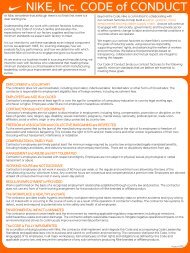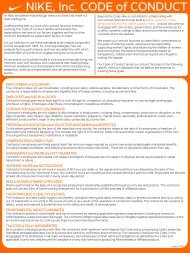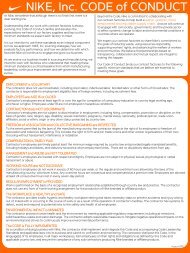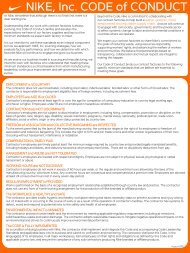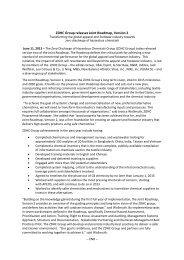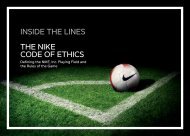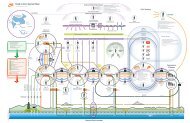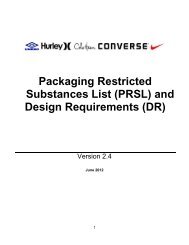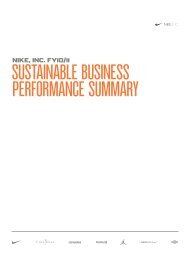COC CLS - Healthy Safety Environment - NIKE, Inc. - The Journey
COC CLS - Healthy Safety Environment - NIKE, Inc. - The Journey
COC CLS - Healthy Safety Environment - NIKE, Inc. - The Journey
Create successful ePaper yourself
Turn your PDF publications into a flip-book with our unique Google optimized e-Paper software.
OCCUPATIONAL EXPOSURE LIMITS<br />
b. Evaluate the risk associated with hazards (including sampling for comparison to available OELs,<br />
as determined necessary)<br />
c. Identification of control measures to reduce the risk (e.g. local exhaust, ventilation, atmospheric<br />
monitoring, etc.).<br />
2. POLICIES & PROCEDURES—Each facility must implement procedures to reduce or minimize the risk<br />
associated with each process and/or work area that include, as a minimum, the following:<br />
a. Prevention of hazards:<br />
• Documented process for approval of all materials, processes and equipment that may<br />
impact worker exposures.<br />
• Substitution of less hazardous or non-hazardous materials and processes.<br />
b. Exposure assessment (e.g. sampling) plan for all contaminants (including biological).<br />
c. Review of employee complaints and absentee records to determine the possibility of exposure<br />
related health problems.<br />
d. Contractors must comply with the most restrictive recognized regulation or consensus standard<br />
of either their nation’s legal or health requirements, the American Conference of Governmental<br />
Industrial Hygienists (ACGIH), Threshold Limit Values (TLVs), US Occupational <strong>Safety</strong> and Health<br />
Administration (OSHA) for permissible Exposure limits. Standards selected must provide the<br />
greatest level of protection to employees in the work environment.<br />
e. Consideration for maintaining contaminants below exposure limits must be given to engineering<br />
controls (such as local exhaust or general ventilation) before use of personal protective<br />
equipment. When provided:<br />
• Local exhaust must be vented directly outdoors or to pollution control equipment.<br />
• HVAC (heating, ventilation and air conditioning) outdoor air intakes and other vents must<br />
not be located in close proximity to potential sources of contamination (e.g.- downwind<br />
of exhausts, near places where motor vehicle emissions collect).<br />
f. Exposure control equipment must be in proper working order, inspected and maintained.<br />
g. Treatment plan for biological hazards (e.g. legionella, mold) when found to be present at<br />
unacceptable levels.<br />
3. TRAINING—All employees with management, supervisory oversight or direct potential for<br />
occupational exposure must be provided with exposure management training at the time of initial<br />
assignment and annually thereafter. Training must cover as a minimum:<br />
• Applicable regulations and procedures.<br />
• General explanation of worker exposure risks.<br />
• Exposure pathways (e.g. inhalation, dermal absorption, by open wound).<br />
• Tasks that might cause exposure.<br />
<strong>Safety</strong> <strong>CLS</strong> – Page 2 Revised 01.01.12



